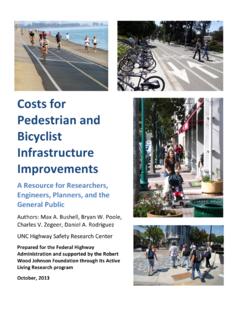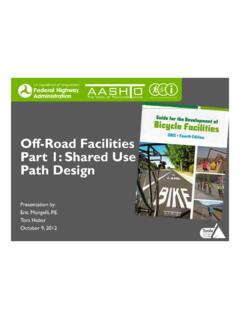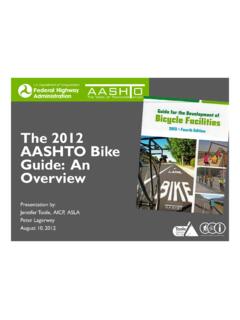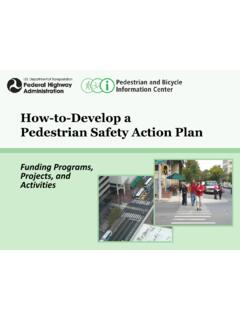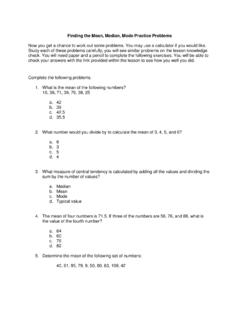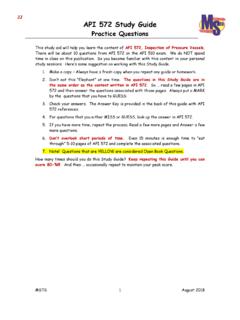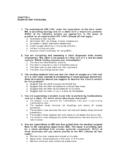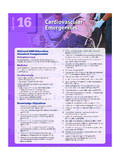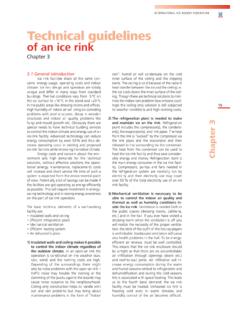Transcription of GUIDE FOR CURING OF PORTLAND CEMENT - PBIC
1 GUIDE for CURING of PORTLAND CementConcrete Pavements, Volume IPUBLICATION NO. FHWA-RD-02-099 JANUARY 2005 Research, Development, and TechnologyTurner-Fairbank Highway Research Center6300 Georgetown PikeMcLean, VA 22101-2296 Foreword CURING has long been recognized as an important process in constructing durable concrete pavements. Proper CURING allows the concrete to develop its potential strength and durability. Inadequate CURING can result in surface damage in the form of plastic shrinkage cracking, spalling, and erosion of paste. Since many variables influence the choice of CURING materials and when and how to apply CURING , the guidance contained in this document should be very helpful to those responsible for concrete CURING operations.
2 It was developed through a review of the literature and of other available guidance supplemented by laboratory testing as necessary where information was lacking. It places particular emphasis on attention to details with respect to moisture retention and concrete temperature control. This is Volume I of two volumes. Sufficient copies of this report are being distributed to provide eight copies to each FHWA Resource Center, four copies to each FHWA Division, and a minimum of six copies to each State highway agency. Direct distribution is being made to the division offices for their forwarding to the State highway agencies. Additional copies for the public are available from the National Technical Information Service (NTIS), 5285 Port Royal Road, Springfield, Virginia 22161.
3 Fifty copies of CURING of PORTLAND CEMENT Concrete Pavements, Volume II Final Report (FHWA-HRT-05-038) will be distributed, and Volume I and Volume II will be available online at T. Paul Teng, Director, Office of Infrastructure Research and Development Notice This document is disseminated under the sponsorship of the Department of Transportation in the interest of information exchange. The Government assumes no liability for the use of the information contained in this document.
4 This report does not constitute a standard, specification, or regulation. The Government does not endorse products or manufacturers. Trademarks or manufacturers' names appear in this report only because they are considered essential to the objective of the document. Quality Assurance Statement The Federal Highway Administration (FHWA) provides high-quality information to serve Government, industry, and the public in a manner that promotes public understanding. Standards and policies are used to ensure and maximize the quality, objectivity, utility, and integrity of its information. FHWA periodically reviews quality issues and adjusts its programs and processes to ensure continuous quality improvement.
5 Technical Report Documentation Page1. Report No. FHWA-RD-02-099 2. Government Accession No. 3. Recipient s Catalog No. 5. Report Date January 2005 4. Title and Subtitle GUIDE FOR CURING OF PORTLAND CEMENT CONCRETE PAVEMENTS 6. Performing Organization Code: CEERD-GM-C 7. Author(s) Toy S. Poole 8. Performing Organization Report No. 10. Work Unit No. 9. Performing Organization Name and Address Structures Laboratory USAE Research and Development Center (ERDC) 3909 Halls Ferry Road Vicksburg, MS 39180-6199 11. Contract or Grant No. DTFH61-98-Y-50030 13. Type of Report and Period Covered 12. Sponsoring Agency Name and Address Federal Highway Administration 6300 Georgetown Pike McLean, VA 22101-2296 14.
6 Sponsoring Agency Code 15. Supplementary Notes Contracting Officer s Technical Representatives (COTR): Stephen Forster and Peter Kopac, HRDI-11 16. Abstract This document provides guidance on details of concrete CURING practice as they pertain to construction of PORTLAND CEMENT concrete pavements. The GUIDE is organized around the major events in CURING pavements: CURING immediately after placement (initial CURING ), CURING during the period after final finishing (final CURING ), and termination of CURING and evaluation of effectiveness of CURING . Information is presented on selection of CURING materials and procedures, analysis of concrete properties and jobsite conditions, and on ways to adjust CURING practice to account for specific project conditions.
7 17. Key Words PORTLAND CEMENT concrete pavements, CURING 18. Distribution Statement 19. Security Classif. (of this report) Unclassified 20. Security Classif. (of this Page) Unclassified 21. No of Pages 49 22. Price Form DOT F (8-72) Reproduction of completed page authorized ii SI* (MODERN METRIC) CONVERSION FACTORS APPROXIMATE CONVERSIONS TO SI UNITSS ymbol When You Know Multiply By To Find Symbol LENGTH in inches millimeters mm ft feet meters m yd meters m mi miles kilometers km
8 AREA in2square inches square millimeters mm2ft2 square feet square meters m2yd2 square yard square meters mi2square miles square kilometerskm2 VOLUME fl oz fluid ounces milliliters mL gal gallons liters L ft3 cubic feet cubic meters m3 yd3 cubic yards cubic meters m3 NOTE: volumes greater than 1000 L shall be shown in m3 MASS short tons (2000 lb) megagrams (or "metric ton") Mg (or "t") TEMPERATURE (exact degrees) oF Fahrenheit 5 (F-32)/9 Celsius oC or (F-32)
9 ILLUMINATION cd/m2 FORCE and PRESSURE or STRESS lbf poundforce newtons N lbf/in2poundforce per square inch kilopascals kPa APPROXIMATE CONVERSIONS FROM SI UNITS Symbol When You KnowMultiply ByTo Find Symbol LENGTHmm millimeters inches in m meters feet ft m meters yardsyd km miles mi AREA mm2 square millimeters square inches in2 m2 square meters square feet ft2 m2 square yards yd2 ha hectares km2 square square miles mi2 VOLUME mL milliliters fluid ounces fl oz L liters gallons gal m3 cubic meters cubic feet ft3 m3 cubic meters cubic yards yd3 MASS (or "t") megagrams (or "metric ton") short tons (2000 lb) T TEMPERATURE (exact degrees)
10 OC Celsius +32 Fahrenheit oF ILLUMINATION lx lux foot-candles fc cd/m2 foot-LambertsflFORCE and PRESSURE or STRESS N newtons poundforce lbf kPa kilopascals poundforce per square inch lbf/in2*SI is the symbol for th International System of Units. Appropriate rounding should be made to comply with Section 4 of ASTM E380. e(Revised March 2003) iii TABLE OF CONTENTS CHAPTER 1. 1 CHAPTER 2. GENERAL TESTING, ANALYSIS, AND PLANNING BEFORE 3 Concrete Materials and Mixture Proportions Effect on 4 Determination of Bleeding for Job 8 Importance of Time of Initial 9 Anticipate Probable Drying and Thermal Stress Conditions on the 10 Analysis of Multiple Factors Affecting Early Moisture-Loss 13 Planning for Potential Corrective 14 CHAPTER 3.
